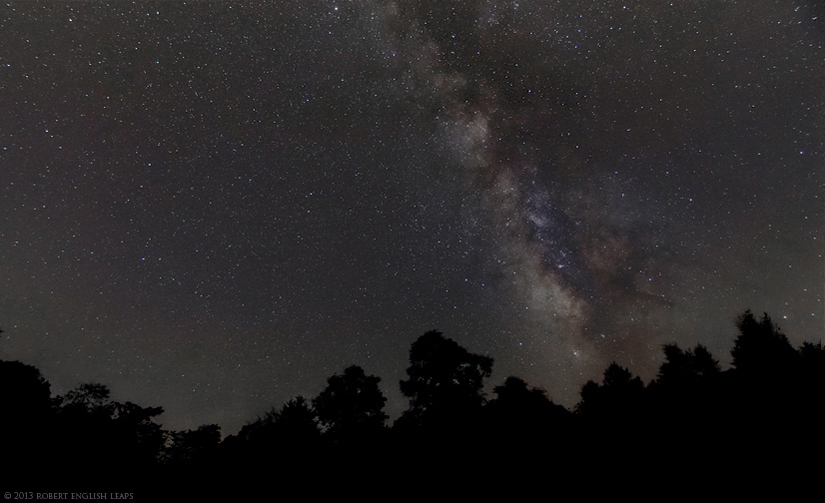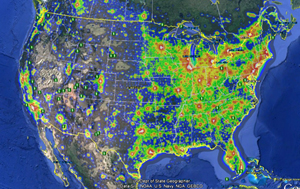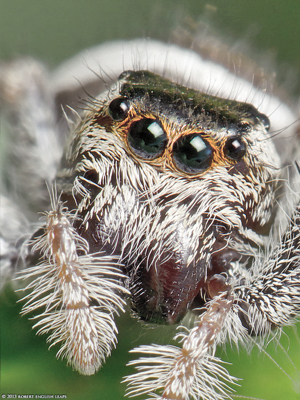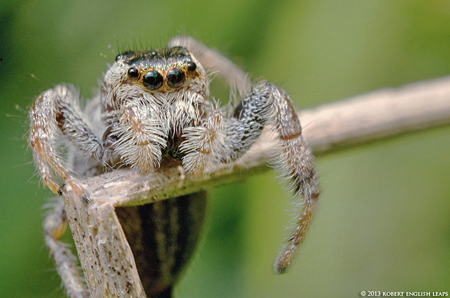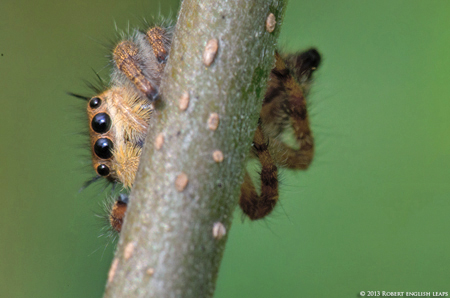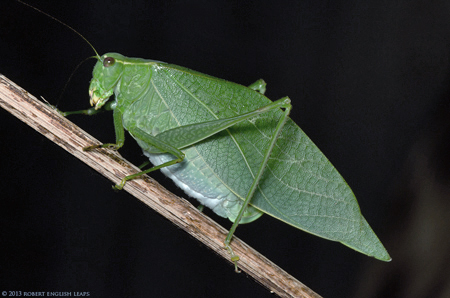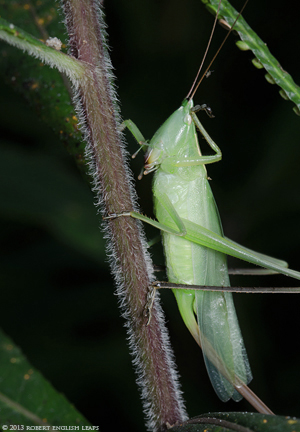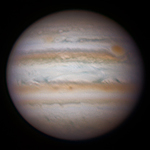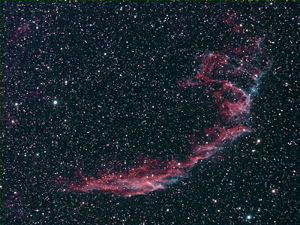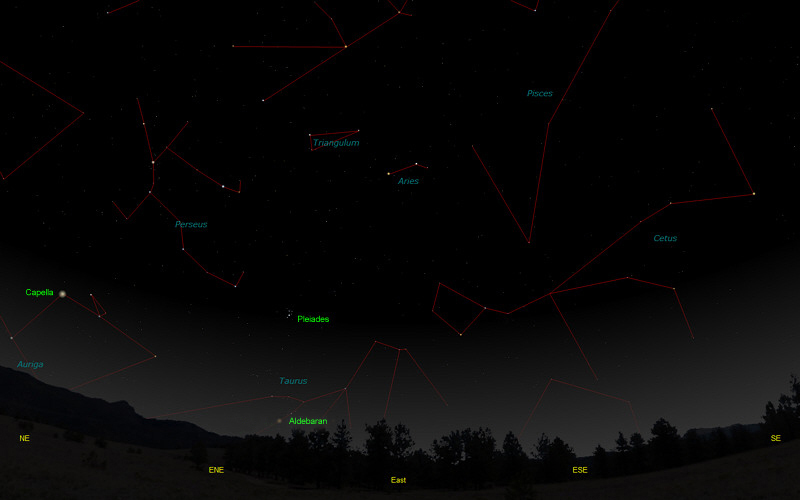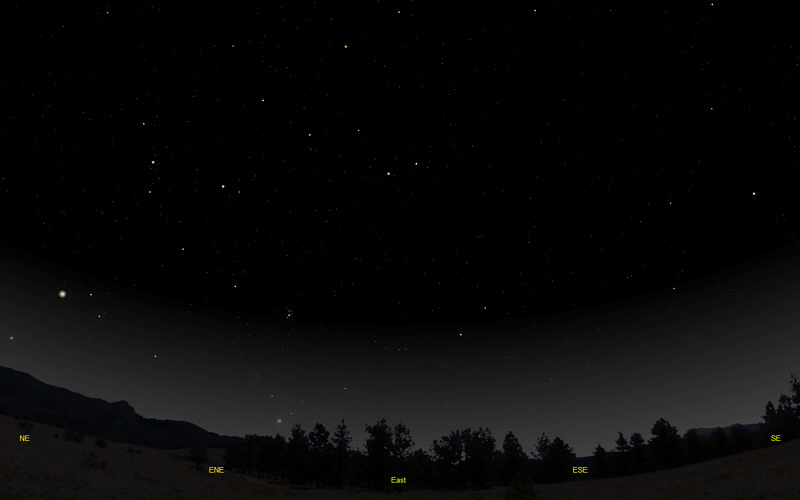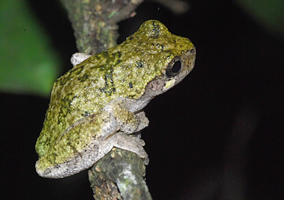The purpose of this feature is to give scout leaders, educators and naturalists an idea of some of the natural events coming up each month. We will try to cover a variety of natural events ranging from sky events to calling periods of amphibians, bird and mammal watching tips, prominent wildflowers and anything else that comes to mind. We will also note prominent constellations appearing over the eastern horizon at mid-evening each month for our area for those who would like to learn the constellations. If you have suggestions for other types of natural information you would like to see added to this calendar, let us know! Note: You can click on the hyperlinks to learn more about some of the featured items. To return to the Calendar, hit the "back" button on your browser, NOT the "back" button on the web page. All charts are available in a "printer friendly" mode, with black stars on a white background. Left clicking on each chart will take you to a printable black and white image. Please note that images on these pages are meant to be displayed at 100%. If your browser zooms into a higher magnification than that, the images may lose quality. Though we link book references to nationwide sources, we encourage you to support your local book store whenever possible. Notes and Images From September 2013
A cold front brought clear skies on September 5th and we took this image of the Milky Way over the south end of our field. We are looking into the great core of the galaxy just above the tree line. Dark nebulae are seen in silhouette against the bright star fields. The bright star Altair in Aquila is at the top edge to the left of center and the red giant Antares in Scorpius is just above the trees at the right. The "Teapot" of Sagittarius is just to the left of the brightest star cloud, also just above the trees. Many bright star clusters are visible. The most prominent cluster is Messier 7, just above the trees to the right of center. It is sometimes called Ptolemy's Cluster, as it was he who first recorded it around 130AD. Other bright areas are the Lagoon Nebula, the small Sagittarius star cloud and the Scutum star cloud.
Some of my earliest memories of the night sky include seeing the Milky Way. Only later, when I became interested in astronomy, did I realize that when I was looking at the Milky Way in Cygnus, I was seeing the majestic spiral arms of our galaxy arcing over my head. Sadly, light pollution from Franklin to the west, Murfreesboro to the east and Nashville to the north is slowly taking the Milky Way away from us. The image at right shows the degree of light pollution in North America. There are few unpolluted areas east of the Mississippi River. Our best view was from the campground at Luna Lake in eastern Arizona, at 8,000 feet elevation. We could see shadows cast by the Milky Way on the side of our trailer, and clouds that drifted across the Milky Way were sharp-edged silhouettes. Our only hope of preserving our nighttime skies lies in the use of full cutoff light fixtures and a more sensible approach to outdoor lighting. You may want to check out the International Dark Sky Association's web site.
I've always thought that if spiders wanted a representative to improve their image they should choose a jumping spider. Besides being beautiful and harmless to humans, they represent the largest spider family in the world. The jumping spider family, Salticidea, includes 13% of all spider species worldwide. Sizes range from a body length of 1 millimeter up to around 22 millimeters. They are said to rank high among the invertebrates in their visual acuity. They often swivel their head around to watch you as you approach them, and are quite inquisitive. They sometimes jump on the lens of the camera being used to photograph them, and the first thing I do when one disappears from my camera viewfinder is to check the end of my lens. They have eight eyes, four forward facing, and four more that can see to the side and rearward. Often you can see in their large forward-facing eyes the reflection of their own hair, the leaf they are sitting on, and sometimes your own reflection.
They catch their prey by leaping on it from some distance away. Their forward facing eyes apparently allow them to accurately judge the distance to their prey and whether or not they will be able to subdue it. When they jump, they trail a silken "safety line" that allows them to sometimes retreat, or climb back to a perch if they miss and fall. If they are foraging and miss their jump, they also sometimes use the trailing thread to swing back and forth until they contact another leaf or branch. Unlike many other spiders, they do not spin webs to catch prey. They do sometimes spin a small web at night in which to sleep, and sometimes they spin a web for protection against the elements and for the protection of their eggs. Habitats vary widely. The female Golden Jumping Spider at left was in an overgrown flower bed that had a few young ash trees and some blackberries and greenbrier. I found several species of jumping spiders in this habitat just by checking it from time to time on sunny days.
Prey usually consists of small invertebrates, including other species of spiders. Some jumping spiders are said to include nectar in their diet. Most are said to have a life span of around a year. I imaged this immature Black and Red Jumping Spider, Phidippus clarus, on September 9th. It reminded me a little bit of how my own hair looks when I first get out of bed. Jumping spiders are well worth the time to seek out. They are very beneficial in controlling many pest species. Take your time searching for them and you may be lucky enough to find one of these miniature wonders.
One of the late summer and early fall sounds we hear a lot at our farm is the Lesser Anglewing. Their call is a rapid fire stacato burst of 3 or 4 notes. Earphones or buds will help to hear this call and the one below. We usually begin hearing them in late August and they call at least through the end of September. Although we also hear the Greater Anglewing, we haven't been lucky enough to see one. The Greater Anglewing's call is a long series of high tics. Both species are leaf mimics, and they can be very difficult to spot when they are in foliage.
Another late singer is the Round-tipped Conehead. We usually hear them in August. Like the other coneheads, they have a distinctive cone-shaped forehead. Always try to get close enough to a conehead to look at the shape of the tip of the cone, as well as any markings on the tip. These markings along with the call (and the frequency of the call, if you record it) will help you identify the species. The Round-tipped Conehead has a circular tip to its cone, and the tip has a single black stripe across it. The call is a very dry, electrical-sounding buzz, not as loud as a Robust Conehead, and higher pitched (14kHz versus 8kHz). The habitat is dry weedy fields. If you leave a portion of your grass long in August, you may get this species. This individual looks like it's wiping its brow, probably in response to to a tiny Springtail that was sitting on its brow a moment before the image was taken. If you look carefully, you can see the Springtail has hopped up onto one of the antennae. Clicking on the image at right will take you to a larger version of the image. Recommended: The Songs of Insects (book and CD), Lang Elliott and Wil Hershberger. Online: The Songs of Insects, Lang Elliott and Wil Hershberger
Sky Events for October 2013: Comet Ison grows brighter in October, but will still be below naked eye visibility. The comet will become brighter in late November and early December, but it is uncertain how bright it will be at its peak. Now is the time to be making your plans for imaging the comet and dusting off your equipment. For many comets, all you need for a good view is a pair of binoculars. The Orionid Meteor Shower peaks October 21st. A waxing gibbous Moon will reduce the number of meteors visible. The radiant will be visible in the early morning hours. The Hunter's Moon, the first full moon after the Harvest Moon, occurs on October 18th. Evening Sky: Saturn is very low in the southwest at dusk at the beginning of October, only about 12 degrees above the southwest horizon, in Libra. Bright Venus is easy to see in the western sky at dusk throughout October. Look for it about 30 minutes after sunset. Morning Sky:
Jupiter rises around 12:14am CDT at the beginning of the month in Gemini. For the best telescopic views, wait until just before dawn to view the planet. Mars rises around 2:53am CDT in Cancer. Too far away to show much detail through a telescope, it is only about 4 seconds of an arc in apparent diameter. All times noted in the Sky Events are for Franklin, Tennessee and are Central Daylight Time. These times should be pretty close anywhere in the mid-state area.
Constellations: The views below show the sky looking east at 9:30pm CDT on October 15th. The first view shows the sky with the constellations outlined and labeled. Star and planet names are in green. Constellation names are in blue. The second view shows the same scene without labels. Prominent constellations include Andromeda, Perseus, Triangulum, the Triangle, Aries, the Ram, and Cetus, the Sea Monster. Auriga, the Charioteer, with its bright star Capella, and Taurus, the Bull, are rising in the northeast. The bright star Aldebaran, a red giant representing the eye of the bull, should just be rising. Above Aldebaran, look for the Pleiades, a beautiful open star cluster. Also called the "Seven Sisters," it has been known since antiquity. In Japan it is known as Subaru, and the Subaru automobile is named for this cluster. Before the Gregorian calendar reform in 1582, the Pleiades culminated around midnight on October 31st, and it has been traditionally associated with Halloween.
Fall is a great time to search for the very faint Veil Nebula. This supernova remnant is high in the sky this time of year, and you can sometimes spot it with 10x50 binoculars on very clear moonless nights. You won't see the fine detail or the colors you see in the image at right, but it's fun to try and catch the faint smoky wisps against a starry background.
You can find a binocular finder chart and tips for spotting the Veil
Nebula here. I spotted the eastern
side of the nebula on September 26th. I don't think I've ever seen
the western side with binoculars The embedded bright star 52 cygni
seems to dazzle my eyes too much to see the nebulosity there. Using
averted vision and looking to one side of the nebula's position may help
you spot it.
On Learning the Constellations: We advise learning a few constellations each month, and then following them through the seasons. Once you associate a particular constellation coming over the eastern horizon at a certain time of year, you may start thinking about it like an old friend, looking forward to its arrival each season. The stars in the evening scene above, for instance, will always be in the same place relative to the horizon at the same time and date each October. Of course, the planets do move slowly through the constellations, but with practice you will learn to identify them from their appearance. In particular, learn the brightest stars for they will guide you to the fainter stars. Once you can locate the more prominent constellations, you can "branch out" to other constellations around them. It may take you a little while to get a sense of scale, to translate what you see on the computer screen or what you see on the page of a book to what you see in the sky. Look for patterns, like the stars that make up the constellation of Perseus. The earth's rotation causes the constellations to appear to move across the sky just as the Sun and the Moon appear to do. If you go outside earlier than the time shown on the charts, the constellations will be lower to the eastern horizon. If you observe later, they will have climbed higher. To observe faint objects, it's always better to wait until they are high in the sky. As each season progresses, the earth's motion around the sun causes the constellations to appear a little farther towards the west each night for any given time of night. The westward motion of the constellations is equivalent to two hours per month. Recommended: Sky & Telescope's Pocket Star Atlas is beautiful, compact star atlas. A good book to learn the constellations is Patterns in the Sky, by Hewitt-White. You may also want to check out at H. A. Rey's classic, The Stars, A New Way to See Them. For skywatching tips, an inexpensive good guide is Secrets of Stargazing, by Becky Ramotowski. A good general reference book on astronomy is the Peterson
Field Guide,
A Field Guide to the Stars and Planets, by Pasachoff. The book retails for around $14.00. Starry Night has several software programs for learning the night sky. Visit the Starry Night web site at www.starrynight.com for details. The Virtual Moon Atlas is a terrific way to learn the surface features of the Moon. And it's free software. You can download the Virtual Moon Atlas here. Cartes du Ciel (described in the monthly notes above) is a great program for finding your way around the sky. It is also free, and can be downloaded here. Apps: We really love the Sky Safari 3 Pro application described here. For upcoming events, the Sky Week application is quite nice. Both apps are available for both I-phone and Android operating systems.
Amphibians:
Listen for Southern Leopard Frogs calling during their fall breeding period. Listen also for Spring Peepers to call from patches of woods. Upland Chorus Frogs sometimes give a very dry, raspy version of their call in October. Warm-weather species like treefrogs seldom call now, but you can sometimes find them foraging in trees and shrubs. You can locate many of the frogs and toads that have been calling more frequently earlier in the year by driving the back roads slowly on rainy nights. This is a two person job. One person watches the road for amphibians and one person looks out for other vehicles. Continue to look for salamander species that breed in the fall, like the Marbled Salamander. Recommended: The Frogs and Toads of North America, Lang Elliott, Houghton Mifflin Co. Archives (Remember to use the back button on your browser, NOT the back button on the web page!) Natural Calendar September 2013 Natural Calendar February 2013 Natural Calendar December 2012 Natural Calendar November 2012 Natural Calendar September 2012 Natural Calendar February 2012 Natural Calendar December 2011 Natural Calendar November 2011 Natural Calendar September 2011 Natural Calendar February 2011 Natural Calendar December 2010 Natural Calendar November 2010 Natural Calendar September 2010 Natural Calendar February 2010 Natural Calendar December 2009 Natural Calendar November 2009 Natural Calendar September 2009 Natural Calendar February 2009 Natural Calendar December 2008 Natural Calendar November 2008 Natural Calendar September 2008 Natural Calendar February 2008 Natural Calendar December 2007 Natural Calendar November 2007 Natural Calendar September 2007 Natural Calendar February 2007 Natural Calendar December 2006 Natural Calendar November 2006 Natural Calendar September 2006 Natural Calendar February 2006
Natural Calendar December 2005
Natural Calendar November 2005
Natural Calendar September 2005
Natural Calendar February 2005
Natural Calendar December 2004
Natural Calendar November 2004
Natural Calendar September 2004
Natural Calendar February 2004
Natural Calendar December 2003
Natural Calendar November 2003
Natural Calendar September 2003 Natural Calendar February 2003 Natural Calendar December 2002 Natural Calendar November 2002 Nature Notes Archives: Nature Notes was a page we published in 2001 and 2002 containing our observations about everything from the northern lights display of November 2001 to frog and salamander egg masses. Night scenes prepared with The Sky Professional from Software Bisque All images and recordings © 2013 Leaps |
|||||||||||||||||||||||
